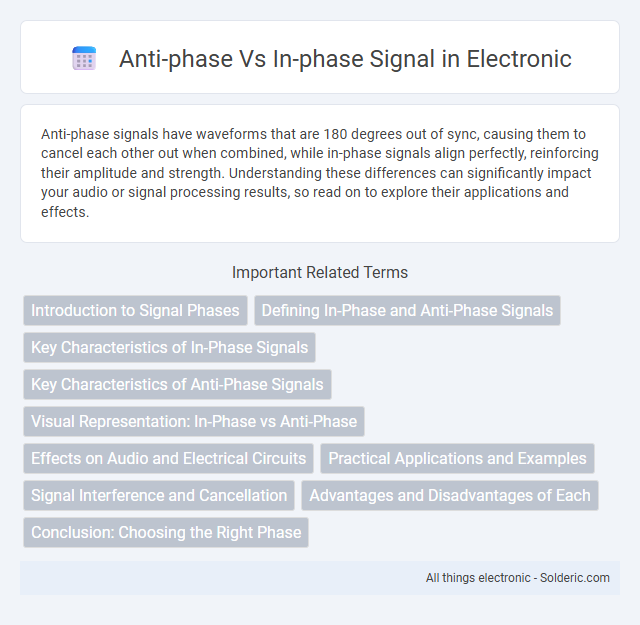Anti-phase signals have waveforms that are 180 degrees out of sync, causing them to cancel each other out when combined, while in-phase signals align perfectly, reinforcing their amplitude and strength. Understanding these differences can significantly impact your audio or signal processing results, so read on to explore their applications and effects.
Comparison Table
| Feature | Anti-Phase Signal | In-Phase Signal |
|---|---|---|
| Definition | Two signals with a 180-degree phase difference | Two signals synchronized with zero phase difference |
| Waveform Relationship | Opposite peaks and troughs | Aligned peaks and troughs |
| Interference | Destructive interference, can cause signal cancellation | Constructive interference, signal reinforcement |
| Use Cases | Noise cancellation, differential signaling | Standard signal transmission, synchronization tasks |
| Signal Example | +1, -1 amplitude pairs | +1, +1 amplitude pairs |
| Effect on Power | Power reduction when combined | Power increase when combined |
Introduction to Signal Phases
Signal phases describe the relative alignment of waveforms in time, crucial for understanding interference patterns in electrical and audio signals. In-phase signals have waveforms that peak and trough simultaneously, leading to constructive interference and signal reinforcement. Anti-phase signals are 180 degrees out of phase, causing destructive interference that can cancel or reduce the amplitude of the combined signal, affecting Your system's performance and clarity.
Defining In-Phase and Anti-Phase Signals
In-phase signals occur when two waveforms align perfectly, matching their peaks and troughs to reinforce each other's amplitude. Anti-phase signals happen when one waveform is inverted relative to the other, causing peaks to coincide with troughs, which can lead to signal cancellation. Understanding the difference between in-phase and anti-phase signals is crucial for optimizing your audio and communication systems to avoid interference and maximize clarity.
Key Characteristics of In-Phase Signals
In-phase signals have identical waveforms and frequencies, aligning perfectly so their peaks and troughs occur simultaneously, resulting in constructive interference and increased amplitude. These signals maintain a zero-degree phase difference, ensuring coherent signal addition that enhances signal strength and reliability. Understanding your system's response to in-phase signals enables optimized performance in communication and audio applications.
Key Characteristics of Anti-Phase Signals
Anti-phase signals occur when two waveforms are 180 degrees out of phase, causing destructive interference that significantly reduces the overall signal amplitude. This phase difference results in signal cancellation at points where the waves are equal in magnitude but opposite in polarity. Understanding anti-phase behavior is essential for optimizing audio mixing and signal processing to prevent unwanted phase cancellation that can degrade your sound quality.
Visual Representation: In-Phase vs Anti-Phase
In-phase signals visually align with waveforms perfectly overlapping, showing synchronized peaks and troughs, which results in constructive interference and amplified amplitude. Anti-phase signals display waveforms with peaks aligning to troughs of the opposing wave, creating a 180-degree phase difference that leads to destructive interference and signal cancellation. This visual contrast is crucial in disciplines like audio engineering and signal processing, where phase alignment affects sound quality and signal integrity.
Effects on Audio and Electrical Circuits
In audio and electrical circuits, in-phase signals combine constructively, resulting in increased amplitude and improved sound clarity or signal strength. Anti-phase signals cause destructive interference, leading to signal cancellation, reduced volume, and potential phase distortion, negatively affecting audio quality or circuit performance. Your system's design must account for phase relationships to ensure optimal audio output or signal integrity.
Practical Applications and Examples
In-phase signals are crucial in wireless communications, enabling coherent signal combining for enhanced data transmission and reception quality. Anti-phase signals find practical use in noise-canceling headphones, where destructive interference cancels ambient noise, improving audio clarity. Understanding these phase relationships helps optimize your audio and communication systems for performance and clarity.
Signal Interference and Cancellation
In-phase signals align their wave peaks and troughs, resulting in constructive interference that amplifies the overall signal strength. Anti-phase signals, with wave peaks aligned against troughs, cause destructive interference leading to signal cancellation and reduced amplitude. Understanding this dynamic helps optimize Your audio setups and minimize unwanted noise in communication systems.
Advantages and Disadvantages of Each
In-phase signals offer advantages such as constructive interference, resulting in stronger signal amplitude and improved clarity in communication systems, but they can suffer from signal distortion due to multipath effects. Anti-phase signals provide benefits by canceling out noise and interference through destructive interference, enhancing signal differentiation in applications like noise-canceling headphones, though they may lead to signal attenuation and potential loss of information. Understanding the trade-offs between in-phase and anti-phase signals is crucial for optimizing performance in audio processing, telecommunications, and signal modulation systems.
Conclusion: Choosing the Right Phase
Choosing the right phase between anti-phase and in-phase signals depends on the desired audio outcome and application context. In-phase signals reinforce each other, providing a clear and powerful sound, while anti-phase signals cancel out certain frequencies, which can create effects like noise reduction or unique spatial audio textures. Understanding the interaction of phase alignment is crucial for optimizing sound quality in recording, mixing, and speaker placement.
anti-phase vs in-phase signal Infographic

 solderic.com
solderic.com